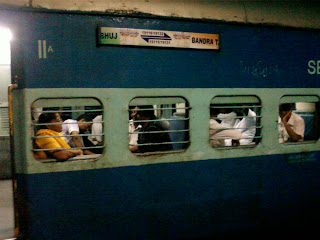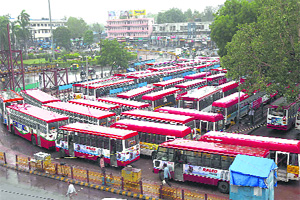COASTAL TOWNS SCALING NEW HEIGHTS
By Abdul Hafiz Lakhani
Saurashtra: Money, Masti and Mazaa
—Chitralekha Survey
On average, there are three annual famines in a decade in Saurashtra and during these hard times, impoverished people from the rural areas migrate to safer pastures in South Gujarat. Be it Surat or Ahmedabad, immigrants from Saurashtra have dropped their anchors there. But times are changing now. While inaugurating supply of pipeline gas to Morbi-based industries, Narendra Modi, Chief Minister of Gujarat, prophesised that now it was Saurashtra's turn once again. According to him, trend has already begun to reverse.
A latest survey commissioned by Chitralekha lends credence to Mr. Modi's prophecy. The fact that Jamnagar and Rajkot are among the top five positions in the survey proves that the Chief Minister was not off-the-mark. Saurashtra is resurrecting itself again.
Prominent market research company Hansa Research Agency, commissioned by Chitralekha, carried out the comprehensive survey among a cross section of 3369 people spread over 25 districts of Gujarat. The results thus achieved offer a lot to Saurashtra to cheer about. About 100-300 people in the 18 or above age group from each city were asked specific questions on the quality of education, business environment, entertainment facilities, local administration and prevailing corruption and efficiency levels in their cities. Interestingly, the verdict may take many by surprise. The results of the survey proves to be an eye-opener for the people of Gujarat as well as for the mandarins in high places.
The cities that figured in top five ranks are Jamnagar (score 37), Rajkot (score 34), Gandhinagar (score 27), Valsad ( score 25) and Ahmedabad (score 24). This means that people living in places like Vadodara and Surat are disenchanted and disillusioned with the quality of life in their cities. Surat occupies 7th rank and Vadodara 8th position, while Bhavnagar was pushed down to 15th rank. Among the last five positions are Godhra, Bhrooch and Dang, which have time and again been tainted by communal skirmishes. While Amreli occupies the fifth position from the last, the last place is held by historic town Rajpipada, which has consistently hit the lowest position in various categories included in the survey.
Smaller towns like Valsad and Dahod have left behind big cities and what is really surprising is the fact that Jamnagar and Rajkot figure in top five rankings. But these gradings, it seems, are not without logic. The situation in Ahmedabad, Vadodara and Surat have hit the saturation levels. Investment opportunities are fast dwindling there. Besides, the worsening housing and employment scenario there has led people to focus on Saurashtra.
Jamnagar that has already occupied a place in the world map, thanks to the Reliance and Essar oil refineries, is truly turning out to be a booming city. The Reliance Industry that has invested a whopping sum of Rs 27,000 crore is currently undertaking expansion programmes. They are also going in for a Special Economic Zone. Popularly known as the brass city, Jamnagar with a population of six lakh plus people, may now be labelled as the oil city. It has outpaced all other cities, as its growing industrial development has lured hordes of people from outside Gujarat. This has skyrocketed the real estate prices in the last five years by as much as 22 per cent. However, the flip side is that because of outsiders having zeroed in on this city, crime rate has zoomed up. But all in all, the oil refineries have saved the day for Jamnagar. People in Jamnagar are satisfied with electricity, transport, market and telecom facilities.
Rajkot that stood second in the survey is a colourful place where the sun rises lazily past noon. Inhabited by 15 lakh people, Rajkot is a trade centre of Saurashtra with no big industries. But it has 8000 small units, the cumulative turnover of which runs into Rs 3500 crore. Already famous for oil engine, gold ornament business, ice cream and sweet peda, Rajkot is equally popular for real estate speculation business. With a glittering gold ornament business running into Rs 4750 crore, this city has a 3-star hotel and a 4-star university. With Rs 300 crore invested in malls and multiplexes, Rajkot is soon going to have an auto SEZ.
Bhooj-Kutch figures in top ten though ranked nine, its score is 21, same as that of Vadodara. The 2001 earthquake had ravaged the area but Kutch resuscitated itself rapidly after the devastation. The transformation is so complete that new visitors cannot believe that this place had undergone a calamity of massive magnitude. Also, because of its tax-holiday status, its industrial belt has attracted investment of Rs 40,000 crore. The vibrant Kutch has 180 units with investment to the tune of Rs 7946 crore.
Besides, the Saurashtra-Kutch has a huge coastal area with 23 ports that include Kutch-based Kundla and Mundra. This is also said to be one of the reasons for its growing prosperity. The belt stretching from Rajkot to Jamnagar and from Rajkot to Kutch is considered hot from growth point of view.
Even on educational front, Jamnagar has proved to be the number one city, followed by Rajkot, Gandhinagar, Vadodara and the fifth position is held by Valsad. The last five positions are held by Navsari, Godhra, Dang, Bhrooch and lastly Rajpipada.
For overall infrastructure, people have voted Gandhinagar as number one. It is followed by Rajkot, Jamnagar, Ahmedabad and Surat. This category includes facilities like hospitals, roads, water, electricity, banks, transportation, markets, cleanliness, postal services, telecom services, homes for the aged, etc. Here too, poor Rajpipda comes last. Lush green Gandhinagar is known to be a technology-savvy city and people there have no complaints about water or electricity facilities. It also has good medicare facilities. Rajkot is close on the heels of Gandhinagar on this front. But people here are dissatisfied with perpetual water crisis. They are also not happy with the fact that government offices there are not modernised.
Gujaratis are essentially businessmen and therefore they are interested in books of accounts rather than books. As regards business environment, it is Valsad that beats the rest of Gujarat. This category includes criteria like congeniality, ambience, new opportunities, raw material, market potential, suppliers, finance availability, export opportunity etc. Surprisingly Valsad is followed by Dahod.
Not many people know much about Dahod. Situated on the borders of Maharashtra and Madhya Pradesh, this town has a huge grain market. There are quite a few cereal-flour mills. With twin industrial townships and a big railway workshop, Dahod is the first benefactor of the run rays in Gujarat.
Also Valsad, has a developed chemical industry. People based here believe that this is a good centre for new business as well as export opportunities.
Gandhinagar, Ahmedabad and Vadodara do not fare impressively on this front. Their score is average, for the simple reason that they have reached a saturation point. Jamnagar may be ahead in other categories, but people there grumble about lack of business environment and opportunities. Even Bhavnagar known for diamonds and ship-breaking business is ranked third from the last, apparently because of overpopulation and cutthroat competition. People in Rajpipada, Patan, Amreli and Godhra are thoroughly disillusioned.
Business-industry is invariably linked with local administration. If it does not effectively function and is plagued by corruption, it can add to the woes of business people. Dahod has earned the dubious distinction of being number one on corruption front. Ironically, it is number one in terms of business environment. It is followed by Vadhavan, Ahmedabad, Rajkot and Bhooj.
Says Mamata Verma, Collector, posted at Dahod, " Dahod has a huge mandi, it has agro industry. Situated on border, people from Rajasthan and Madhya Pradesh flock this place for doing business. Having a medical centre, Dahod has had a steady growth as government has paid attention despite 75 per cent of population being tribal. Infrastructure facilities have gone up. It has an efficient administration. But since there are 10 claimants for the same plot of land and due to its exorbitant rates, people have got a perception that corruption is rampant. But reality says otherwise."
On the other hand, corruption is comparatively less in small towns like Nadiyad, Junagarh, Bhrooch. Kheda-Nadiyad tops the list in this field and Rajpipada though behind in many categories is ranked fifth in this department.
People in Dahod say that palms have to be greased at local municipality, particularly in water-electricity departments. Rajkot also falls in the same category. Bhooj telecom department is said to be mired in this vice, but Ahmedabad is ahead in corruption race. Of course, the capital offers a little relief in this area but credit for this, of course, goes to Narendra Modi.
Which city can boast of most efficient administration? Here again Jamnagar reigns supreme and stands tall over all other cities and towns. It is followed by Dahod, Himatnagar, Rajkot, Anand and Valsad. The last five positions are held by Bhrooch, Porbandar, Godhra Junagarh and, of course, Rajpipada.
It may, in short, be said that small towns have better administration than big ones. Gandhinagar is less corrupt but people say that its administration is weak.
Administration is quick to respond in Jamnagar, people feel. But in terms of transparency, Dahod attains the number one position. It is followed by Mehsana and Valsad. People in Vadodara and Surat are dissatisfied, whereas milk city Anand is number one in terms of redressal of complaints.
And lastly how is the quality of life in each city? The most important segment of the survey also followed the predictable pattern. When asked about available housing facilities, security, cooperative nature of people, it was once again Jamnagar that proved miles ahead. It was followed by Bhooj, Rajkot, Dahod, and Valsad. And the last five include Kheda, Gandhinagar, Rajpipada, Bhrooch and Godhra.
Jamnagar is ahead in three categories. Bhooj is also a livable city now. Gandhinagar with its greenery comes fifth in this area. People feel insecure here perhaps after the infamous Akshardham attack. Godhra, Bhrooch and Rajpipada have been tainted by communal tensions or inhabitants have developed this perception. They say there is no more fun in living in Vadodara and Surat. People do not help one another and there is hardly any security there.
In short, the conclusion of the survey is that Ahmedabad was once known as Manchester for its cotton mills. Then Vadodara surged forward for its refinery. It was then South Gujarat that became the silver corridor. But now the wind is blowing in direction of Saurashtra. You get money, masti and mazaa here...!!!
In conclusion, it may be inferred from this interesting survey that the high-profile cities are bursting at their seams with fast depleting opportunities and rising levels of disillusionment and disenchantment among people. It therefore comes as no surprise that Saurashtra is once again regaining its old glory and asserting itself in the inexorable march of Gujarat towards prosperity and progress. The survey has also vindicated the stance of the present rulers of the state that the word 'vibrant' is not merely a rhetoric, as is made out to be by critics of the state. It is proving true in every sense of the word.
























